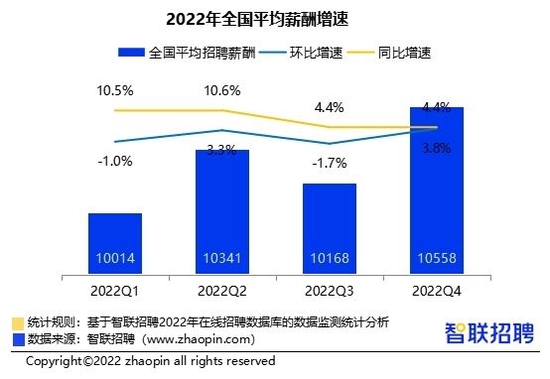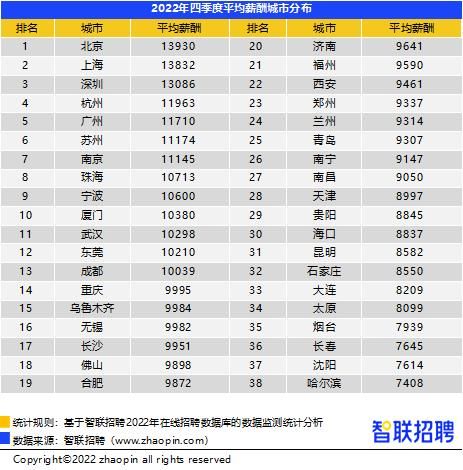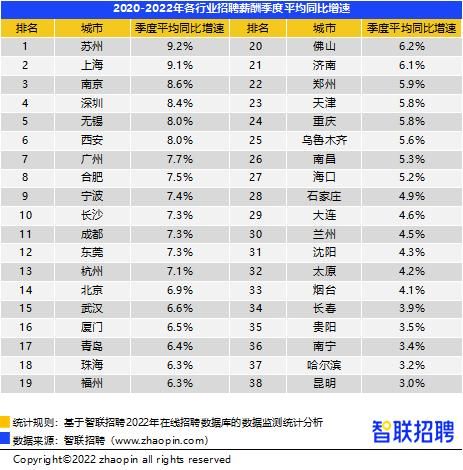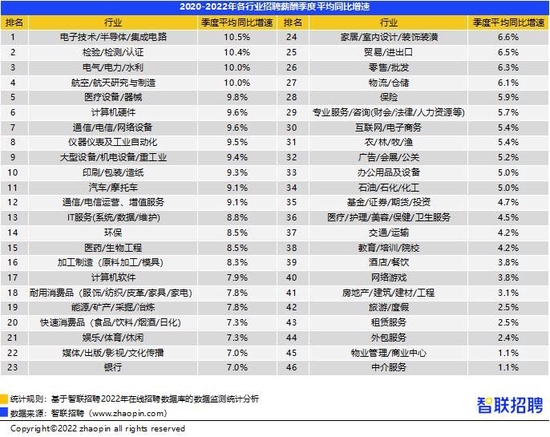Report: The national average recruitment salary in the fourth quarter was 10,558 yuan, an increase of 3.8% from the previous quarter
Source: Sino-Singapore Jingwei
China-Singapore Jingwei reported on January 3 that Zhilian Recruitment recently released the “Report on Recruitment and Salary of Chinese Enterprises”, which shows that the national average recruitment salary in the fourth quarter was 10,558 yuan, the year-on-year growth rate narrowed, and the month-on-month increase.
The average recruitment salary in the fourth quarter rose by 3.8% from the previous quarter
The report shows that in 2022, the recruitment salary of Chinese enterprises will rise amid fluctuations. In the peak season of spring recruitment in the first quarter, companies recruited more basic positions such as sales, and the recruitment salary fell seasonally, down 1% compared with the fourth quarter of last year; in the second quarter, when the epidemic spread in Shanghai, Beijing and other places, production and operation were damaged, and companies shrank The scale of recruitment and the maintenance of talent demand for just-needed and key technical positions, the national average salary level was raised to 10,341 yuan; the third quarter entered the autumn recruitment season, enterprises released more recruitment positions, and the national average salary fell by 1.7% month-on-month to 10,168 yuan In the fourth quarter, the epidemic escalated and the scale of recruitment decreased. At the same time, the proportion of jobs that were just in demand increased, driving the average recruitment salary to 10,558 yuan, a month-on-month increase of 3.8%.
In terms of year-on-year comparisons, the average recruitment salary in 38 cities in 2022 will all increase year-on-year, but the year-on-year growth rate will gradually narrow.

Beijing, Shanghai, Shenzhen, Guangzhou and Hangzhou lead the way in salary
According to the report, among the 38 core cities across the country monitored by Zhaopin.com, the salary levels of Beijing, Shanghai, Shenzhen, Guangzhou and Hangzhou still led the way in the fourth quarter.
Beijing tops the list with a monthly recruitment salary of 13,930 yuan, followed by Shanghai (13,832 yuan), and Shenzhen (13,086 yuan), Hangzhou (11,963 yuan) and Guangzhou (11,710 yuan) still maintain the top five salary levels. This quarter, Suzhou, Nanjing, Ningbo, Wuxi, and Hefei in the Yangtze River Delta, Zhuhai, Dongguan, and Foshan in the Pearl River Delta, and cities such as Xiamen, Wuhan, Chengdu, Chongqing, and Changsha also had relatively high recruitment salaries. Cities in Northeast China generally have low wages, and cities such as Harbin (7,408 yuan), Shenyang (7,614 yuan), and Changchun (7,645 yuan) lack competitiveness.

According to the analysis of the report, from 2020 to 2022, the average quarterly growth rate of recruitment salary in 38 cities will be 6.6% year-on-year. Judging from the average growth rate rankings of various cities, Suzhou ranks first, with an average year-on-year growth rate of 9.2% in recruitment and salary in the past three years; Shanghai ranks second, with an average growth rate of 9.1%; Nanjing ranks third, with an average growth rate of 8.6%; The average growth rates of Wuxi, Hefei, Ningbo, and Hangzhou were 8%, 7.5%, 7.4%, and 7.1%, respectively, all higher than the average level of the 38 cities.
In the past three years, the economy in the Yangtze River Delta region has shown strong vitality, driving wages to continue to rise. In addition, the recruitment and salary growth rate of Shenzhen, Guangzhou, Dongguan and other Pearl River Delta cities as well as Xi’an, Changsha, Chengdu, and Beijing is also higher than the average growth rate of the 38 cities.
Salary increases in Northeast cities are relatively slow. The quarterly average year-on-year growth rates of Harbin, Changchun, Shenyang, and Dalian were 3.2%, 3.9%, 4.3%, and 4.6%, respectively. Recruitment salaries are not attractive enough for talents. Cities in western regions such as Kunming, Nanning, Guiyang, and Lanzhou also experienced a year-on-year growth rate of less than 5%, and companies in Yantai, Taiyuan, and Shijiazhuang also experienced relatively low growth rates in recruitment and salary, which lagged behind other cities in the eastern and central regions.

High salaries in the financial and IT Internet industries
In terms of industries, the report shows that in the fourth quarter, the financial and IT Internet industries still had relatively high salaries.
The financial industry has always been a high-paying industry, and funds/securities/futures/investment are at the top of the list. The average monthly salary for recruitment is 13,583 yuan, and the salary level of banks (12,010 yuan) and insurance (11,523 yuan) ranks relatively high. The high-tech industry is knowledge-intensive, technology-intensive, with a large proportion of R&D personnel, and the industry’s salaries are generally relatively high. In the fourth quarter, industries such as electronic technology/semiconductor/integrated circuit (12,276 yuan), IT services (12,042 yuan), computer software (11,940 yuan), computer hardware (11,392 yuan), and communication/telecom/network equipment (11,339 yuan) were in the recruitment market. The salary levels of aviation/aerospace research and manufacturing, medicine/bioengineering, instrumentation and industrial automation are also relatively high.
At the same time, salaries in the hotel, catering, and tourism industries are relatively low. The monthly salaries for recruitment are 7,562 yuan and 8,028 yuan respectively.

Salary growth in high-tech manufacturing is impressive
The report mentioned that judging from the quarterly average year-on-year growth rate of recruitment salary in various industries in the past three years, the growth rate of high-tech manufacturing salary is impressive. In recent years, under market leadership and policy support, my country’s high-tech manufacturing industry has developed rapidly. Companies have competed for talents with high salaries, and the overall recruitment salary of the industry has risen rapidly. According to Zhaopin recruitment data, from 2020 to 2022, the average year-on-year growth rate of salary in aviation/aerospace research and manufacturing industry will be 10%, and the salary of computer hardware, communication/telecom/network equipment, instrumentation and industrial automation, large-scale equipment/mechanical and electrical equipment/heavy industry, The average salary increase in high-tech manufacturing fields such as automobiles/motorcycles also exceeded 9%. Salaries in the medical equipment/apparatus and pharmaceutical/bioengineering industries also increased by 9.8% and 8.5% respectively.
During the epidemic period, my country’s tourism industry encountered a “cold winter”. Enterprises’ employment needs and recruitment salary growth tended to be cautious. The average year-on-year growth rate of salary in the past three years was only 2.5%, and talents flowed to other industries. Although the hotel/catering industry has recovered temporarily, the overall wage growth is not optimistic, with an increase of 3.8%. Affected by policies, the real estate and education and training industries are in a period of adjustment, and the increase in corporate salaries has slowed down, with growth rates below 5%. At the same time, intermediary services, property management, outsourcing services, leasing services, and online games, transportation, beauty care services and other industries have relatively slow salary growth.

In terms of occupations, the report shows that in the fourth quarter, high-skilled positions such as management and technology were still high-paying occupations. Among them, IT management/project coordination (28,380 yuan) has the highest recruitment salary, and senior management (23,119 yuan) and sales management (15,870 yuan) also rank relatively high. Among the technical posts, the salary level of hardware development (16,107 yuan), software/Internet development/system integration (16,102 yuan), electronics/electrical appliances/semiconductor/instrumentation (14,924 yuan), and telecommunications/communication technology development and application (13,762 yuan) average salary higher. Management and technical positions are crucial to the development of enterprises, and the skill requirements are generally high. Enterprises often adopt high salary strategies in the recruitment of these talents.
In addition, securities/futures/investment management/services, energy/minerals/geological exploration, consulting/advisor/research/data analysis are also among the high-paying occupations. The salary level of low-skilled positions is relatively low, and the ranks of “blue-collar” positions such as chefs (7,173 yuan), supermarket and hotel services (6,963 yuan), technicians (6,863 yuan), and housekeeping services (5,096 yuan) are at the bottom, and their salaries are not competitive. .

The report finally mentioned that for highly technical occupations, sometimes skill requirements are more important, and mastering the key skills becomes the key to obtaining high salaries. In the fourth quarter, in the list of high-paying skills for semiconductor development posts (electronics/electrical appliances/semiconductors/instruments), the salary of chip design skills was at the top.
The report believes that the intensified competition of global technology companies has driven the upgrade of enterprises’ demand for chips. Among semiconductor development jobs in the fourth quarter, the salary of analog-digital hybrid chip design skills ranks first, with an average monthly salary of 40,233 yuan, and the recruitment salary of SoC chips, ASIC chips, analog chip design, chip architecture design, digital chip design and other skills is 3-4 10,000 yuan also led by a large margin. (Sino-Singapore Jingwei APP)

Editor in charge: Liu Wanli SF014
media reports
Sina interface Sina
This article is transferred from: https://readhub.cn/topic/8mhmNzx4VGX
This site is only for collection, and the copyright belongs to the original author.